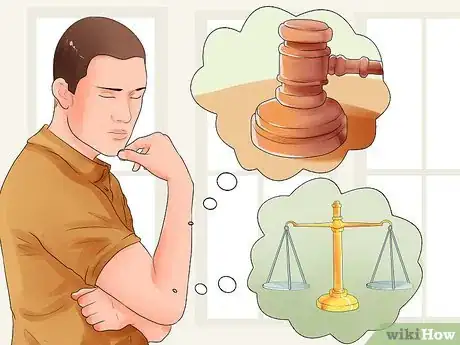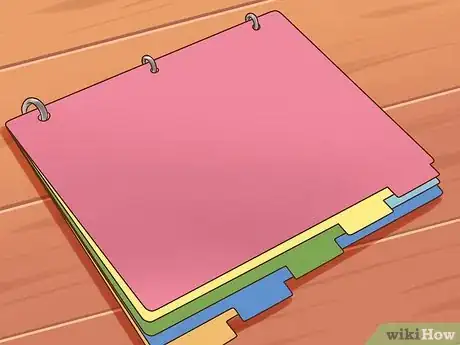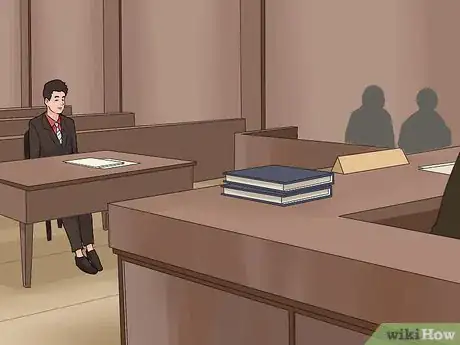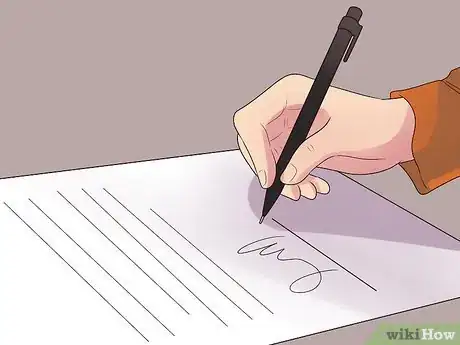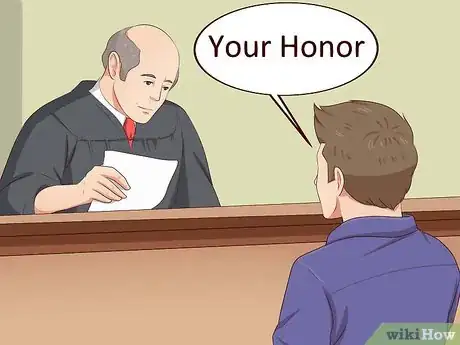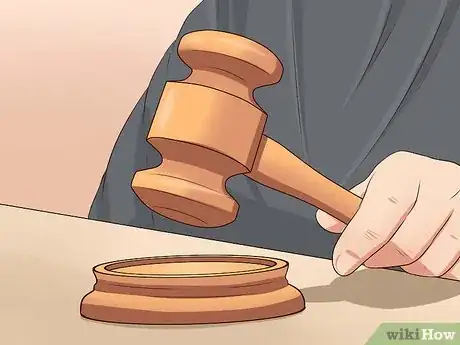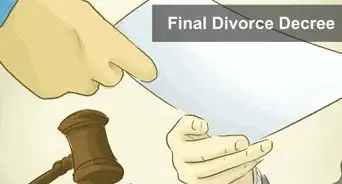This article was co-authored by Clinton M. Sandvick, JD, PhD. Clinton M. Sandvick worked as a civil litigator in California for over 7 years. He received his JD from the University of Wisconsin-Madison in 1998 and his PhD in American History from the University of Oregon in 2013.
There are 15 references cited in this article, which can be found at the bottom of the page.
This article has been viewed 28,190 times.
People want to represent themselves in court for a variety of reasons. For example, they may be involved in a civil trial but cannot afford a lawyer. Although defendants have the right to an attorney in a criminal trial, they do not have the same right in a civil trial. Furthermore, some people feel that they can handle their case better than an attorney could.[1] Whatever your reasons for representing yourself, you will need to do extensive preparation and understand the different elements of a trial.
Steps
Preparing to Represent Yourself
-
1Give serious thought to hiring an attorney. You should not make the decision to represent yourself in court lightly. In a criminal trial, for example, you should certainly have a lawyer. Furthermore, you will also need an attorney for civil trials where you face over $100,000 in damages.[2]
- You can get by without a lawyer if you are in small claims court. Also, you may be able to successfully represent yourself in a civil trial that is worth $25,000 to $100,000.[3]
- Nevertheless, you should consider hiring an attorney if you believe the case is complicated or could become complicated. You may also want a lawyer if you are too close to the case emotionally and doubt that you can be objective.[4]
-
2Check if you can represent yourself. Not all courts will allow you to appear “pro se.” For example, Florida probate courts will allow you to represent yourself only if the executor is the sole beneficiary or if the estate is very small.[5] All other people appearing in Florida probate court need a lawyer.
- To check if you are required to have a lawyer for your case, call the court clerk and ask.
Advertisement -
3Learn the different court systems. The United States has two general court systems: a federal court system and individual state court systems. Different cases can be brought in each system. If you are the plaintiff in a lawsuit, you will need to learn the difference so that you can bring your suit in the correct court.
- As a general rule, you should file a case that deals with state law in state court. State law cases typically involve personal injury suits (like medical malpractice or slip-and-fall cases), breach of contract, family law, and landlord-tenant cases. State courts almost always can hear a lawsuit involving events that happened within the state’s boundaries.[6]
- Federal courts hear a more limited range of cases. Federal courts typically hear discrimination claims, unfair competition claims, as well as cases alleging violations of copyright and trademark law.[7] Federal courts will also hear cases where the parties are from different states if the amount in controversy exceeds $75,000, exclusive of costs and fees.[8]
- If you file your case in the wrong court, it will be dismissed. You will then have to file in the appropriate court provided the statute of limitations hasn’t expired.[9]
-
4Read the rules of evidence. Each state has its own rules of evidence. These rules will spell out what evidence is admissible in court and what evidence isn’t. The federal court system also has its own rules of evidence.
- The Federal Rules of Evidence are available online. You can find a copy by searching the internet.
- State rules of evidence may be harder to find. If you have access to a law library, then you can search for a copy there. Some states may have posted them online. Even if you can’t find the state rules, then you should read the federal rules since they are often similar.
- One of the most important rules you will want to know is the rule against hearsay evidence. Hearsay is any statement made outside of court which is offered as proof of the matter asserted. For example, if a bystander said at a crash scene, “The blue car was going too fast,” then it would be hearsay to admit that statement in court as proof that the blue car was driving too fast.
-
5Read the rules of civil or criminal procedure. The federal court system also has rules of civil procedure and rules of criminal procedure. These rules cover all aspects of a civil or criminal trial: deadlines for filing papers with the court, acceptable methods of service, what kinds of motions the court allows, etc. You should locate a copy of the rules online and read them.
- States also have their own rules of procedure. As with the state’s rules of evidence, you should look online and in a law library. However, unlike the rules of evidence, state rules of procedure often differ significantly from the federal rules. Accordingly, you should not use the federal rules of procedure as a substitute.
-
6Get the local rules. In addition to rules of evidence and procedure, each judge has “local rules.” These rules are specific to his or her courtroom. For example, the judge might specify that he wants a certain number of copies of any motion delivered to his chambers before the hearing date. Local rules are sometimes posted on the court’s website.
- You can request local rules by contacting the judge’s chambers. You will not know what judge you are appearing before until the lawsuit is filed. So you can wait a little bit before requesting local rules.
-
7Seek legal assistance whenever necessary. At some point you may have a legal question you cannot find the answer to. Even if you have access to the court’s law library, you may be overwhelmed and unable to find the correct answer. If this happens, then you may want to seek the advice of a lawyer. You have many options.
- Self-help centers. Some courthouses have centers where you can go for legal assistance. For example, many California Superior Courts have self-help centers in their courthouses.[10] You can ask staff to look over your paperwork, advise you on next steps, and answer your questions.
- Legal aid organizations. These organizations are often non-profits that provide free or reduced-fee legal advice to people with low incomes. You can find a legal aid organization near you by visiting the Legal Services Corporation’s website at www.lsc.gov and click “Find Legal Aid” link at the top of the page.
- Law Libraries. Law libraries can be found in most law schools and courthouses. These libraries can be an incredible source for information and help. You can often find forms and practice manuals with the help of library employees. Practice manuals provide step-by-step instructions on how to tackle a particular legal issue and they are used every day by practicing lawyers. For example, if you need to file a personal injury claim, you can go to a law library and find a civil procedure practice manual, which will walk you through the steps of filing a case.
- Court-appointed attorneys. In a criminal case, you are entitled to a court-appointed attorney if you face at least six months in jail.[11] You can also have a lawyer appointed as “stand by” counsel. Stand-by counsel can answer questions, look over any forms you must fill out, and appear in court with you.
- Private attorneys. You may also think about hiring a lawyer to perform discrete tasks. Historically, a lawyer took over the entire representation and did everything. Today, most states allow lawyers to provide “limited scope representation.” Under this arrangement, the lawyer does only the tasks you agree to. For example, the lawyer may look over documents or coach you as you prepare for trial. If you are interested in limited scope representation, you can call lawyers and ask if they provide this service.[12]
-
8Commit to being organized. The typical lawsuit or criminal prosecution includes many pre-trial hearings. These hearings can involve disputes about what evidence you are entitled to, or they may be simple status “updates.” Regardless of the substance of the hearing, you need to attend every single one.
- You should get a notebook in which you can write your hearing dates. Also create binders or folders so that you can keep all of your paperwork in one place.
- The court will also set strict deadlines for filing motions. You must follow these deadlines. If you ever need an extension because of an emergency, then you should reach out to the judge and the other party before the deadline passes.
-
9Sit in on another trial. A good way to learn about trials is to watch one.[13] Most trials are open to the public. If you have time, then you might want to spend at least a couple days watching court proceedings.
- Pay attention to where the parties sit as well as how they describe their case to the judge.[14]
Filing Motions
-
1Understand pleadings and motions. You start a lawsuit by filing a Complaint. This document alleges the facts surrounding the lawsuit and asks the court for relief, such as money damages to compensate the plaintiff for his or her injuries. The defendant who receives the complaint then typically files an Answer, in which he admits or denies the allegations and asserts any legal defenses. Complaints and answers are classed as “pleadings.”
- In a lawsuit, you also might file a motion. A motion is any request for the judge to do something in a case. You can file a motion in a variety of situations: to ask the judge’s permission to do something or to ask the judge to compel the other side to do something.
- You often need the judge’s permission to extend deadlines or approve fee waivers. You typically need the judge to compel the other side to turn over evidence or answer questions you have served on them.
- To learn more about motions, see File a Motion in Court Without an Attorney.
- In a lawsuit, you also might file a motion. A motion is any request for the judge to do something in a case. You can file a motion in a variety of situations: to ask the judge’s permission to do something or to ask the judge to compel the other side to do something.
-
2Learn about service of process. Whenever you file a pleading or a motion with a court, you will need to send a copy to the other party. The rules of procedure should spell out acceptable methods of service of process.
-
3Participate in discovery. Discovery is a process where the parties to a lawsuit can request documents or information in the possession or control of the other party. Discovery generally happens outside court. There are several common methods of obtaining evidence through discovery, which should be discussed in the applicable rules of procedure:[15]
- Requests for production: you may request documents or other physical evidence that relates to the case. For example, you may seek copies of contracts, communications (emails, letters, etc.), or employment files.
- Interrogatories: these are written questions that one party sends to another which must be answered under oath.
- Depositions: in a deposition, one party answers questions in person under oath. Depositions usually take place at a lawyer’s office with a court reporter present. If the party deposed cannot later appear at trial, then sometimes the deposition testimony can be read into evidence at trial.
-
4Understand dispositive motions. A “dispositive” motion is one that ends a lawsuit. After discovery, either party may file a “motion for summary judgment” in a civil trial. Alternately, a defendant in a criminal trial may file a motion to dismiss or, if trial has started, a motion for directed verdict.[16]
- In a civil trial, a judge can grant a motion for summary judgment if one party shows that there are no issues of material fact and that it is entitled to judgment as a matter of law.[17]
- If you are defending against a summary judgment motion, you want to show that some important fact is in dispute, e.g., whether the defendant was driving too fast in an automobile accident case. If there is evidence both for and against that fact, then the judge shouldn’t grant a motion for summary judgment.
- In a criminal case, you can argue that the case should be dismissed because the prosecution’s evidence does not establish guilt beyond a reasonable doubt.[18]
- In a civil trial, a judge can grant a motion for summary judgment if one party shows that there are no issues of material fact and that it is entitled to judgment as a matter of law.[17]
Appearing in Court
-
1Arrive early. You should always arrive at court early, whether for a hearing or for the trial itself. Most courthouses now have security that all visitors must pass through. Give yourself plenty of time to find parking and get to the appropriate courtroom with about 15 minutes to spare.
- You also should not bring food or drinks into court. If you need something to eat, consume it entirely outside of the courthouse.
-
2Dress appropriately. Although you do not need to wear a suit to represent yourself in court, you should still do your best to look clean and neat. Men should wear long pants with a belt, a collared-shirt, and a tie.
- Women should wear a dress, skirt (not too short), or slacks with a nice blouse or top.
- In no circumstances should you wear shorts, hats, halter or see-through tops, flip flops, belly shirts, ripped jeans, or baggy pants that hang below the hips. Also avoid clothing with offensive words or imagery.
-
3Address the judge with respect. Whenever you speak to the judge, always say, “Your Honor” or “Judge [last name].” Also stand when the judge enters or leaves the courtroom.
Representing Yourself during a Trial
-
1Pick a jury. If you are in civil or criminal court, you have the option of using a jury to decide your case. In criminal trials, the jury usually has 12 members. In civil trials, the number can vary by state, with juries of 12 or 9 being common. In civil trials held in state courts, jury verdicts do not always have to be unanimous.[19]
- Jurors are selected in a process called “voir dire.” The judge calls a panel of jurors (maybe 12 at a time) to the jury box to be questioned by the judge and the parties. Based on the juror’s answers, the plaintiff and defendant can each strike a juror for cause (e.g., the juror admitted to being biased). You are also given a number of “peremptory” challenges. You can use a peremptory challenge to strike a juror without having to give the judge a reason.[20]
- You should use your questions to try and uncover juror bias. First, ask open-ended questions to get the jurors talking. Asking, “What are your hobbies” could make jurors more comfortable. Then you can ask their opinions on topics that relate to your lawsuit. If you are suing a police officer for excessive force, ask about their opinions on the police. A juror who praises the police may not be open-minded to your case.
- Do not assume that a juror’s race, age, or gender will make them biased against you. A person’s experience is much more important in shaping their worldview.
- If you represent yourself, you might want to forego a jury trial and ask for a bench trial. Successfully selecting a jury is complicated and usually requires a lawyer’s help.[21] If you are in small claims court, then you will most likely not have the option of a jury. Instead, the judge will decide the case.
-
2Give an opening statement. A trial begins with each side delivering an opening statement. An effective opening statement provides the jury (or judge) with a sneak peek of what the evidence will show. You should focus on your key facts—those facts that are most persuasive in your favor.
- You also should disclose “bad facts.” A bad fact is anything that the other side will bring up during the course of trial to support their case. You can mention bad facts early in your own opening statement to take the sting out of them.
- Be confident in your delivery. Jurors focus on tone, words, and nonverbal behavior. Do not be fidgety or refuse to look at the jury. Stand in place and speak to each juror.
- Also be brief. Jurors begin to lose interest after about fifteen minutes, so you should try to keep your opening statement under that.
-
3Present your evidence and witnesses. To win your case, you will need to call witnesses and introduce documents or objects into evidence. The plaintiff will go first and the defendant will go second.
- Think about the most logical way to present your evidence. For example, you could introduce evidence chronologically. If you are suing someone for causing a car accident, you could call a passenger in your car as the first witness. Then you can introduce the police officer who arrived at the scene. Next, you could present a doctor who can testify as to the injuries you suffered and your rehabilitation.
- You must always “lay a foundation” for any document or object you want to introduce into evidence. To lay a foundation, you need a witness to testify that the object is what you claim it is.[22] For example, if you have a picture of a car crash, you need a witness to testify that she recognizes the scene and how she knows the photo was taken of the scene.
- You must also establish that witnesses have personal knowledge of anything they testify about. If you want a witness to testify that your neighbor’s dog barks all night, you have to establish that she was close enough to hear it on the night in question. You can elicit this information with questions: “Where do you live?” “Where were you during the evening of March 3, 2015?” “Did you hear anything?”
-
4Cross-examine the other party’s witnesses. You want to undermine the other party’s witnesses. You can do this in a variety of ways: by impeaching them, by emphasizing limitations on their ability to perceive, or by eliciting testimony that they have been convicted of a crime of moral turpitude.#* You can impeach a witness by introducing a prior inconsistent statement. If a witness testifies that she saw the green car hit the brown car, then she can be impeached if she testified in a deposition that she didn’t see which car hit the brown car.
- You can also highlight the witness’s limitations. If the witness claims to have heard a conversation across a crowded room, you can draw out how crowded and noisy the room was. By doing so, you undermine the jury’s faith that the witness observed what he claimed.
- You may also be able to undermine a witness by introducing evidence of a conviction for perjury or a felony. These convictions can undermine the credibility and character of the witness.
-
5Object to evidence when necessary. Always pay attention to the questions the other side asks witnesses. They may try to introduce evidence inappropriately. For example, the other side could elicit hearsay evidence from a witness or try to introduce a document without laying a proper foundation. You should always object.
- To object, immediately stand after the other side asks the question and clearly state, “Objection, Your Honor.” Then state the reason for your objection: for example, “Hearsay.”
- You must object in order to preserve any issue for appeal. Even if the other party inappropriately introduces evidence, you have forfeited your ability to raise the issue on appeal if you do not object in a timely manner.
-
6Deliver a closing argument. Each side also delivers a closing argument. You should use yours to sum up the evidence and explain how it supports your case. Be confident and look the jurors in the eyes.
- After explaining how the evidence supports your case, rebut the other side’s evidence. Explain why their witnesses are mistaken or not believable.
- Begin and end strong. Research shows that people remember the first and last things that they hear. Accordingly, you should begin and end your closing statement with strong points. Remind the jurors of the most persuasive evidence in your case.
-
7Appeal if necessary. If you lose at trial, you may have the right to appeal that decision to a higher court. You will have to file a Notice of Appeal. Many courts have pre-printed Notice of Appeal forms which you can use. After the verdict, ask the judge or clerk if there is a form.
- If the court doesn’t have a form, then you should draft a Notice of Appeal. You will format it like every other motion: a caption, a title, and then state that you are taking an appeal. Here is sample language: “Please take notice that [insert your name] hereby appeals to the [name of the appellate court] from the judgment entered [date judgment is entered].”[23] Then add a date and your signature.
- You should file your Notice of Appeal as soon as possible.
- If you wish to appeal, you should give serious consideration to hiring an attorney. Appellate practice is in many ways more complicated than the rules that govern trials. It is very easy to lose an appeal if you do not know what you are doing.
References
- ↑ http://www.courts.ca.gov/1076.htm
- ↑ http://litigation.findlaw.com/going-to-court/should-you-represent-yourself-in-court.html
- ↑ http://litigation.findlaw.com/going-to-court/should-you-represent-yourself-in-court.html
- ↑ http://www.courts.ca.gov/1076.htm
- ↑ http://statewideprobate.com/estate-probate-questions/probate-faqs/
- ↑ http://www.nolo.com/legal-encyclopedia/subject-matter-jurisdiction-state-federal-29884-2.html
- ↑ http://www.nolo.com/legal-encyclopedia/subject-matter-jurisdiction-state-federal-29884.html
- ↑ https://www.law.cornell.edu/uscode/text/28/1332
- ↑ http://www.nolo.com/legal-encyclopedia/subject-matter-jurisdiction-state-federal-29884.html
- ↑ http://www.courts.ca.gov/selfhelp-selfhelpcenters.htm
- ↑ http://www.nolo.com/legal-encyclopedia/defendants-rights-during-court-trial-29793.html
- ↑ http://www.courts.ca.gov/1085.htm
- ↑ http://litigation.findlaw.com/going-to-court/should-you-represent-yourself-in-court.html
- ↑ http://www.courts.ca.gov/1076.htm
- ↑ http://www.nolo.com/legal-encyclopedia/formal-discovery-gathering-evidence-lawsuit-29764.html
- ↑ http://www.criminaldefenselawyer.com/resources/criminal-defense/criminal-defense-case/what-a-summary-judgment-a-criminal-trial
- ↑ http://www.criminaldefenselawyer.com/resources/criminal-defense/criminal-defense-case/what-a-summary-judgment-a-criminal-trial
- ↑ http://www.criminaldefenselawyer.com/resources/criminal-defense/criminal-defense-case/what-a-summary-judgment-a-criminal-trial
- ↑ http://litigation.findlaw.com/legal-system/must-all-jury-verdicts-be-unanimous.html
- ↑ http://www.apa.org/monitor/2009/01/jn.aspx
- ↑ http://litigation.findlaw.com/going-to-court/should-you-represent-yourself-in-court.html
- ↑ https://www.law.cornell.edu/rules/fre/rule_901
- ↑ https://www.nycourts.gov/ctapps/forms/NoticeofAppeal.pdf

